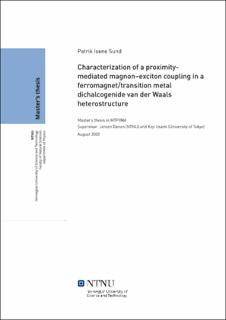| dc.contributor.advisor | Danon, Jeroen | |
| dc.contributor.advisor | Usami, Koji | |
| dc.contributor.author | Sund, Patrik Isene | |
| dc.date.accessioned | 2021-09-28T18:39:44Z | |
| dc.date.available | 2021-09-28T18:39:44Z | |
| dc.date.issued | 2020 | |
| dc.identifier | no.ntnu:inspera:57076746:32684782 | |
| dc.identifier.uri | https://hdl.handle.net/11250/2785567 | |
| dc.description.abstract | Sterk kobling mellom heterogene kvantesystemer kan brukes til å konstruere hybridkvantesystemer, der de unike egenskapene til de individuelle systemene kan anvendes for innovative muligheter. Denne tesen gjør rede for et eksperiment med mål om å karakterisere koblingen mellom magnoner i en tynnfilm med yttrium-jern-granat (YIG) og eksitoner i atomisk tynne lag av et overgangsmetalldikalkogenid (TMD).
Magnoner er sterke kandidater for anvendelser i kvanteinformasjonsprosessering grunnet evne til å transportere informasjon uten å lide ohmske tap, samt at de kan kobles sterkt til superledende qubits. TMDer, på den andre siden, er 2D-materialer med sterke optiske egenskaper og med mulige anvendelser i syntetisering av kunstige materialer med ekstraordinære egenskaper. Om systemene kan kobles sterkt sammen vil det videre forsterke potensialet til begge systemer for nyskapende anvendelser, spesielt for magnon-baserte hybridsystemer da det kan forsterke optiske egenskaper, hvis svakhet tidligere har vært et hinder for enkelte anvendelser.
Det koblede systemet er en van der Waals-heterostruktur, konstruert ved å feste tynne flak av et TMD oppå en tynnfilm av YIG, der interaksjoner i overflaten fører til at resonansenergien til eksitonene kobles til den transversale magnetiseringen i YIG-filmen gjennom den magnetiske nærhetseffekten ('magnetic proximity effect'). Ved å magnetisere YIG-filmen parallelt med planaksen og eksitere magnoner, vil den oscillerende transversale magnetiseringen forårsaket av magnonene skifte resonansenergien til eksitonene dynamisk. Dersom man så belyser eksitonene med laserlys med en bestemt bølgelengde vil det dynamiske skiftet forplante seg i form av en amplitudemodulasjon i det reflekterte lyssignalet. Koblingen mellom magnonene og eksitonene kan så bestemmes ved å analysere dette signalet.
Tesen presenterer et eksperimentelt oppsett og et sett med eksperimenter som kan generere og analysere et slikt signal, og forankrer det i et robust teoretisk rammeverk for YIG-TMD heterostrukturen inklusiv interaksjon med signaler fra omgivelsene. De eksperimentelle resultatene viser at oppsettet er i stand til å identifisere, og kan anvendes på TMD-flak, i tillegg til å kunne eksitere magnetostatiske magnoner i YIG-filmen. Ytterligere planlagte eksperimenter kunne dessverre ikke gjennomføres grunnet COVID-19-pandemien.
Tesen konkluderer med en diskusjon om utfordringer som fremkom under eksperimentet, og mulige retninger for fremtidige eksperimenter. | |
| dc.description.abstract | Strong coupling between heterogeneous quantum systems enable the construction of hybrid quantum systems, which can leverage the unique properties of the constituent systems for novel applications. In this thesis, I describe an experiment aiming to characterize the coupling between magnons in a thin film of yttrium iron garnet (YIG) and excitons in atomically thin layers of a transition metal dichalcogenide (TMD).
Magnons are strong candidates for applications in quantum-information processing, as they can carry information without suffering from Ohmic losses, and have been demonstrated to couple strongly to superconducting qubits. TMDs on the other hand, are 2D materials with strong optical properties and potential applications in the creation of artificial materials with novel properties. A strong coupling between magnons and excitons in TMDs would expand the range of applicability of both systems, and in particular could provide magnon-based hybrid quantum systems with a strong optical response, which has been a bottleneck in previous attempts at implementations.
The coupling is achieved by piling thin flakes of TMD onto a YIG film to make a van der Waals heterostructure, where the exchange interactions in the interface between the materials lead to a magnetic proximity effect, which couples the resonance energy of the excitonic modes to the out-of-plane magnetization in the YIG film. The YIG film is magnetized with an in-plane magnetic field, after which a magnon population is excited, resulting in an oscillating out-of-plane magnetization which induces a dynamic shift in the exciton resonance energy. By probing the excitons with a laser at a fixed wavelength, the dynamic shift in the resonance manifests itself as an amplitude modulation, which can be measured to determine the magnon--exciton coupling strength.
The thesis details an experimental setup and a set of experiments designed to generate and analyze such an experimental signal, including a robust theoretical framework to describe the YIG--TMD heterostructure and its interaction with the probe laser. The results of the experiments show that the setup is capable of identifying and addressing TMD flakes, as well as exciting magnetostatic modes in the YIG film, however, subsequent experiments could not be performed due to delays resulting from the COVID-19 pandemic. The thesis concludes by addressing the challenges encountered in the acquisition of the experimental results, and discussing future directions for successive experiments. | |
| dc.language | | |
| dc.publisher | NTNU | |
| dc.title | Characterization of a proximity-mediated magnon–exciton coupling in a ferromagnet/transition metal dichalcogenide van der Waals heterostructure | |
| dc.type | Master thesis | |
